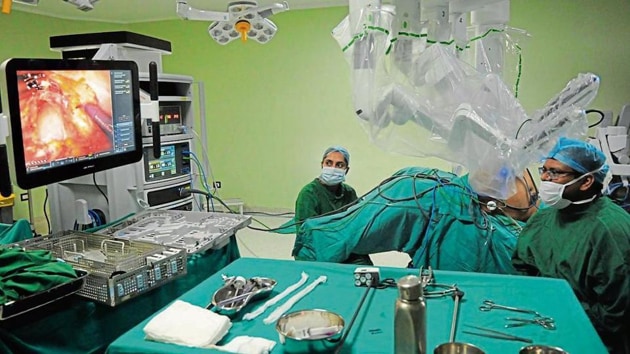Watching machines take over: Robot performs surgery in Gurugram hospital
The surgery was to be performed on a 62-year-old woman who had endometrial cancer (cancer in the inner lining of the uterus) and was likely to go on for about five hours.
As journalists, we get used to ending up in some extraordinary and unfamiliar places and situations. So when asked if I wanted to see a surgery in person, I didn’t think twice before saying yes. After all, it would have helped the story I was writing on robot-assisted surgeries and their presence in Gurugram’s hospitals. Thankfully, robotic surgeries don’t involve open wounds – I like to think I’m fine around blood and wounds but I’ve never been in a situation where a wound has been deliberately created in front of me. Nevertheless I received numerous tips on how to survive the inside of an operation theatre, such as eat light but have a good breakfast or you’ll faint.

The surgery was to be performed on a 62-year-old woman who had endometrial cancer (cancer in the inner lining of the uterus) and was likely to go on for about five hours. Authorisation to enter the operation theatre and consent from the patient was already obtained by the hospital, and a photojournalist and I were escorted in. We were asked to change into scrubs and deposit our bags, as per protocol. “Are you new in the hospital,” a staff member asked me in the dressing room when she noticed how clueless I was.
I reached to see around eight doctors in the large room, about an hour into the surgery. However, none of them were bent over the patient. Instead, they were fixated at a screen on the top of the bed. A giant robot – called the da Vinci – with four arms controlled by a computer – did most of the work while the one of the surgeons gave it directions, from a system a short distance. As the surgeons did their job, I uneasily tried to find a spot to watch them in action; being in the room was overwhelming, to say the least.
“Would you like to look at the screen,” the surgeon asked me. The screen she was referring to was a 3D, high definition one which gave a clear view of the organ being operated on. “Sure,” I replied, not wanting to appear meek. The surgeon then showed me how she positions the camera attached to the robot and controls the arms of the robot to find and cut cancerous cells.
I spoke to the patient two days later when she had been discharged to find she was able to walk, most of the time with little support. “I was a little scared before the surgery but in the end, decided to let go of fears and leave it to the experts. Everything turned out okay,” she said. Meanwhile, I marveled at the change technology has brought to healthcare and wondered what’s next.



